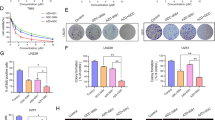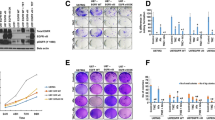Abstract
Basic fibroblast growth factor (bFGF) has been demonstrated to correlate with glioma grade and clinical outcome and has established its possible usefulness as a target for glioma therapy. Vpr has been described as an antitumor agent and displays a potent antitumor nature. Here, we try to investigate whether a combined treatment with bFGF-siRNA and Vpr gene would have a enhanced effectiveness on glioma in vitro and in vivo.After treatments with only Ad-bFGF-siRNA, only Ad-Vpr, and a combination of both, we assessed the changes in cell proliferation, cell cycle, and apoptosis in vitro by the methods of MTT, PI and FITC-AnnexinV double staining, respevtively. In addition, we also evaluated the combined effect of bFGF-siRNA and Vpr gene therapy on glioma in vivo using xenograft glioma models in nude mice. Combined Ad-bFGF-siRNA and Ad-Vpr treatment was more better successful in inhibiting cell proliferation in comparison with treatments of either Ad-bFGF-siRNA or Ad-Vpr alone. Treatment of Ad-Vpr alone or a treatment of a combination of Ad-bFGF-siRNA and Ad-Vpr induced the G2/M cell cycle arrest and apoptosis; however, combined treatment was more effective than the Ad-Vpr treatment alone. Although each single treatment can slow the growth of xenograft glioma, the combined treatment with Ad-bFGF-siRNA and Ad-Vpr was better than either the Ad-bFGF-siRNA or Ad-Vpr treatment alone. Our results suggest that the combination therapy with bFGF-siRNA and Vpr gene can achieve a enhanced activity of anti-glioma, supporting the idea that the combination of these two antitumor agents could open new perspectives in glioma therapy.



Similar content being viewed by others
References
Hutterer M, Knyazev P, Abate A, Reschke M, Maier H, Stefanova N, Knyazeva T, Barbieri V, Reindl M, Muigg A, Kostron H, Stockhammer G, Ullrich A (2008) Axl and growth arrest-specific gene 6 are frequently overexpressed in human gliomas and predict poor prognosis in patients with glioblastoma multiforme. Clin Cancer Res 14(1):130–138
Stupp R, Mason WP, van den Bent MJ, Weller M, Fisher B, Taphoorn MJ, Belanger K, Brandes AA, Marosi C, Bogdahn U, Curschmann J, Janzer RC, Ludwin SK, Gorlia T, Allgeier A, Lacombe D, Cairncross JG, Eisenhauer E, Mirimanoff RO (2005) Radiotherapy plus concomitant and adjuvant temozolomide for glioblastoma. N Engl J Med 352(10):987–996
Auguste P, Gursel DB, Lemiere S, Reimers D, Cuevas P, Carceller F, Di Santo JP, Bikfalvi A (2001) Inhibition of fibroblast growth factor/fibroblast growth factor receptor activity in glioma cells impedes tumor growth by both angiogenesis-dependent and -independent mechanisms. Cancer Res 61(4):1717–1726
Ryther RC, Flynt AS, Phillips JA 3rd, Patton JG (2005) siRNA therapeutics: big potential from small RNAs. Gene Ther 12(1):5–11
Muthumani K, Hwang DS, Desai BM, Zhang D, Dayes N, Green DR, Weiner DB (2002) HIV-1 Vpr induces apoptosis through caspase 9 in T cells and peripheral blood mononuclear cells. J Biol Chem 277(40):37820–37831
Muthumani K, Zhang D, Hwang DS, Kudchodkar S, Dayes NS, Desai BM, Malik AS, Yang JS, Chattergoon MA, Maguire HC Jr, Weiner DB (2002) Adenovirus encoding HIV-1 Vpr activates caspase 9 and induces apoptotic cell death in both p53 positive and negative human tumor cell lines. Oncogene 21(30):4613–4625
McCray AN, Ugen KE, Heller R (2007) Enhancement of anti-melanoma activity of a plasmid expressing HIV-1 Vpr delivered through in vivo electroporation. Cancer Biol Ther 6(8):1269–1275
McCray AN, Ugen KE, Muthumani K, Kim JJ, Weiner DB, Heller R (2006) Complete regression of established subcutaneous B16 murine melanoma tumors after delivery of an HIV-1 Vpr-expressing plasmid by in vivo electroporation. Mol Ther 14(5):647–655
Muthumani K, Choo AY, Hwang DS, Ugen KE, Weiner DB (2004) HIV-1 Vpr: enhancing sensitivity of tumors to apoptosis. Curr Drug Deliv 1(4):335–344
Muthumani K, Lambert VM, Sardesai NY, Kim JJ, Heller R, Weiner DB, Ugen KE (2009) Analysis of the potential for HIV-1 Vpr as an anti-cancer agent. Curr HIV Res 7(2):144–152
Muthumani K, Lambert VM, Shanmugam M, Thieu KP, Choo AY, Chung JC, Satishchandran A, Kim JJ, Weiner DB, Ugen KE (2009) Anti-tumor activity mediated by protein and peptide transduction of HIV viral protein R (Vpr). Cancer Biol Ther 8(2):180–187
Hanahan D, Weinberg RA (2000) The hallmarks of cancer. Cell 100(1):57–70
Jordan JP, Hand CM, Markowitz RS, Black P (1992) Test for chemotherapeutic sensitivity of cerebral gliomas: use of colorimetric MTT assay. J Neurooncol 14(1):19–35
Chen B, Timiryasova TM, Andres ML, Kajioka EH, Dutta-Roy R, Gridley DS, Fodor I (2000) Evaluation of combined vaccinia virus-mediated antitumor gene therapy with p53, IL-2, and IL-12 in a glioma model. Cancer Gene Ther 7(11):1437–1447
Fukui S, Nawashiro H, Otani N, Ooigawa H, Nomura N, Yano A, Miyazawa T, Ohnuki A, Tsuzuki N, Katoh H, Ishihara S, Shima K (2003) Nuclear accumulation of basic fibroblast growth factor in human astrocytic tumors. Cancer 97(12):3061–3067
Baguma-Nibasheka M, Li AW, Murphy PR (2007) The fibroblast growth factor-2 antisense gene inhibits nuclear accumulation of FGF-2 and delays cell cycle progression in C6 glioma cells. Mol Cell Endocrinol 267(1–2):127–136
Aoki T, Kato S, Fox JC, Okamoto K, Sakata K, Morimatsu M, Shigemori M (2002) Inhibition of autocrine fibroblast growth factor signaling by the adenovirus-mediated expression of an antisense transgene or a dominant negative receptor in human glioma cells in vitro. Int J Oncol 21(3):629–636
Takahashi JA, Fukumoto M, Kozai Y, Ito N, Oda Y, Kikuchi H, Hatanaka M (1991) Inhibition of cell growth and tumorigenesis of human glioblastoma cells by a neutralizing antibody against human basic fibroblast growth factor. FEBS Lett 288(1–2):65–71
Marek L, Ware KE, Fritzsche A, Hercule P, Helton WR, Smith JE, McDermott LA, Coldren CD, Nemenoff RA, Merrick DT, Helfrich BA, Bunn PA Jr, Heasley LE (2009) Fibroblast growth factor (FGF) and FGF receptor-mediated autocrine signaling in non-small-cell lung cancer cells. Mol Pharmacol 75(1):196–207
Wang SJ, Wang JH, Zhang YW, Xu XN, Liu HS (2008) Effects of small interfering RNA targeting basic fibroblast growth factor on proliferation and apoptosis of glioma cell line U251. Ai Zheng 27(9):905–909
Acknowledgement
This work was supported by National Natural Sciences Foundation of China (30672158)
Author information
Authors and Affiliations
Corresponding author
Additional information
Biao Zhang and Xuequan Feng contributed equally to this work.
Rights and permissions
About this article
Cite this article
Zhang, B., Feng, X., Wang, J. et al. Combined Antitumor Effect of Ad-bFGF-siRNA and Ad-Vpr on the Growth of Xenograft Glioma in Nude Mouse Model. Pathol. Oncol. Res. 17, 237–242 (2011). https://doi.org/10.1007/s12253-010-9303-5
Received:
Accepted:
Published:
Issue Date:
DOI: https://doi.org/10.1007/s12253-010-9303-5




